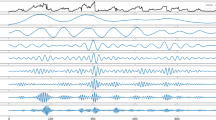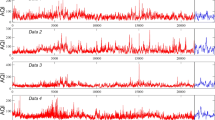Abstract
Air quality has a significant impact on human health, in order to alleviate the air pollution and improve the ability to predict the air quality. In this paper, a prediction model of air quality index composed of variational mode decomposition and temporal convolutional network was proposed. First, in order to reduce the non-stationarity and randomness of the time series, the original air quality index sequence was decomposed by variational mode decomposition, and the decomposition number was determined by the central frequency method to decompose into multiple relatively stable sub-sequences with different frequency scales. Then, the decomposed sub-stable sequence was predicted by the time convolutional network. Finally, the prediction data were integrated and reconstructed to obtain the final prediction results. Comparing the results of other forecasting models by performance evaluation metrics, the combined forecasting model proposed in this paper reduced RMSE by 20.9%, 19.2%, 5.1%, 29.9%, 23.7% on the Beijing dataset. MAPE reduced by 26.6%, 22.3%, 19.5%, 28.9%, 15.0%, respectively. MAE decreased by 19.1%, 20.6%, 9.6%, 29.5%, 23.5%. R2 increased by 4.6%, 4.0%, 0.8%, 14.9%, 5.5% respectively. This proves the accuracy and reliability of the proposed model.












Similar content being viewed by others
Data availability
The source data used to support the findings of this study is available from the corresponding author upon request.
References
Abdul-Wahab SA, Charabi Y, Osman S et al (2019) Prediction of optimum sampling rates of air quality monitoring stations using hierarchical fuzzy logic control system. Atmos Pollut Res 10(6):1931–1943
Baklanov A, Rasmussen A, Fay B et al (2002) Potential and shortcomings of numerical weather prediction models in providing meteorological data for urban air pollution forecasting. Water, Air Soil Pollut Focus 2:43–60
Chen J, Chen K, Ding C et al (2020) An adaptive Kalman filtering approach to sensing and predicting air quality index values. IEEE Access 8:4265–4272
Dai H, Huang G, Wang J et al (2023) VAR-tree model based spatio-temporal characterization and prediction of O3 concentration in China. Ecotoxicol Environ Saf 257:114960
Dai H, Huang G, Zeng H et al (2022) Haze risk assessment based on improved PCA-MEE and ISPO-LightGBM model. Syst 10(6):263
Ding C, Zheng Z, Zheng S et al (2022) Accurate air-quality prediction using genetic-optimized gated-recurrent-unit architecture. Information 13(5):223
Dragomiretskiy K, Zosso D (2013) Variational mode decomposition. IEEE Trans Signal Process 62(3):531–544
Gilik A, Ogrenci AS, Ozmen A (2022) Air quality prediction using CNN+ LSTM-based hybrid deep learning architecture. Environ Sci Pollut Res:1–19
Hu C, Cheng F, Ma L et al (2022) State of charge estimation for lithium-ion batteries based on TCN-LSTM neural networks. J Electrochem Soc 169(3):030544
Katushabe C, Kumaran S, Masabo E (2021) Fuzzy based prediction model for air quality monitoring for Kampala City in East Africa. Appl Syst Innov 4(3):44
Li J, Song Z, Wang X et al (2022a) A novel offshore wind farm typhoon wind speed prediction model based on PSO–bi-LSTM improved by VMD. Energy 251:123848
Li Y, Tang B, Jiang X et al (2022b) Bearing fault feature extraction method based on GA-VMD and center frequency. Math Probl Eng 2022:1–19
Nurcahyanto H, Prihatno AT, Alam MM et al (2022) Multilevel RNN-Based PM10 air quality prediction for industrial internet of things applications in cleanroom environment. Wirel Commun Mob Computi 2022:1874237
Ouyang H, Tang X, Kumar R et al (2022) Toward better and healthier air quality: implementation of WHO 2021 global air quality guidelines in Asia. Bull Am Meteorol Soc 103(7):E1696–E1703
Park SY, Dash UK, Yu J et al (2022) Implementation of an ensemble Kalman filter in the community multiscale air quality model (CMAQ model v5. 1) for data assimilation of ground-level PM 2.5. Geosci Model Dev 15(7):2773–2790
Tian Z, Wang G, Ren Y (2020) Short-term wind speed forecasting based on autoregressive moving average with echo state network compensation. Wind Eng 44(2):152–167
Wang W, Tang Q (2023) Combined model of air quality index forecasting based on the combination of complementary empirical mode decomposition and sequence reconstruction. Environ Pollut 316:120628
Xia X (2021) Study on the application of BP neural network in air quality prediction based on adaptive chaos fruit fly optimization algorithm. MATEC Web of Conf EDP Sci 336:07002
Xu Z, Xia X, Liu X et al (2015) Combining DMSP/OLS nighttime light with echo state network for prediction of daily PM2. 5 average concentrations in Shanghai, China. Atmosphere 6(10):1507–1520
Yang H, Liu Z, Li G (2022) A new hybrid optimization prediction model for PM2. 5 concentration considering other air pollutants and meteorological conditions. Chemosphere 307:135798
Yu J, Zhang L, Peng L et al (2023) Which component of air quality index drives stock price volatility in China: a decomposition-based forecasting method. Financ Res Lett 51:103406
Zeng H, Shao B, Dai H et al (2023) Prediction of fluctuation loads based on GARCH family-CatBoost-CNNLSTM. Energy 263:126125
Zhao J, Guo Z, Guo Y et al (2021) A self-organizing forecast of day-ahead wind speed: selective ensemble strategy based on numerical weather predictions. Energy 218:119509
Funding
This paper is supported by the Natural Science Foundation of Liaoning Province of China (No. 2020-MS-210), the Science Research Project of Liaoning Education Department (No. LJKZ0143) and the Applied Basic Research Program Project of Liaoning Province (No. 2022JH2/101300246).
Author information
Authors and Affiliations
Contributions
Xiaolei Sun: Software, Validation, Writing.
Zhongda Tian: Conceptualization, Methodology, Software, Validation, Writing, and Funding acquisition.
Zhijia Zhang: Software and Validation.
Corresponding author
Ethics declarations
Ethical approval
Not applicable.
Consent to participate
Not applicable.
Consent to publish
The manuscript was vetted and approved for publication by all authors.
Conflict of interest
The authors declare no competing interests.
Additional information
Communicated by: H. Babaie
Publisher’s note
Springer Nature remains neutral with regard to jurisdictional claims in published maps and institutional affiliations.
Rights and permissions
Springer Nature or its licensor (e.g. a society or other partner) holds exclusive rights to this article under a publishing agreement with the author(s) or other rightsholder(s); author self-archiving of the accepted manuscript version of this article is solely governed by the terms of such publishing agreement and applicable law.
About this article
Cite this article
Sun, X., Tian, Z. & Zhang, Z. A new decomposition-integrated air quality index prediction model. Earth Sci Inform 16, 2307–2321 (2023). https://doi.org/10.1007/s12145-023-01028-1
Received:
Accepted:
Published:
Issue Date:
DOI: https://doi.org/10.1007/s12145-023-01028-1




